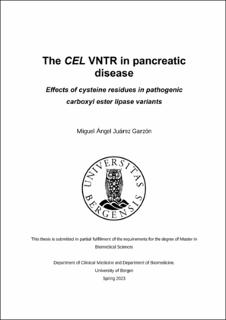| dc.description.abstract | Carboxyl ester lipase (CEL) is a digestive enzyme mainly expressed in the acinar cells of the pancreas. CEL hydrolyses dietary fat, cholesteryl esters and fat-soluble vitamins. The protein is structurally divided into two regions: an N-terminal globular domain and a C-terminal tail encoded by a variable number of tandem repeats (VNTR). The CEL VNTR is highly polymorphic and pathogenic variants of CEL (CEL-MODY and CEL-HYB1) are associated with mutations in this region. CEL-MODY is caused by a single-base pair deletion leading to a frameshift and a truncated CEL protein that introduces ten de novo cysteines not present in the normal protein tail. CEL-MODY causes Maturity-Onset Diabetes of the Young, type 8 (MODY8). The disease is also characterized by exocrine dysfunction and progressive pancreatic deterioration. The CEL-HYB1 allele is a genetic risk factor for chronic pancreatitis that derives from recombination between CEL and its pseudogene CELP, leading to a short aberrant tail that contains two cysteines not found in the normal protein. In this thesis, we aimed to gain new knowledge about the function of the CEL VNTR-encoded tail region, specifically the effect of de novo cysteines in the pathogenic variants. To this end, synthetic constructs of CEL-MODY and CEL-HYB1 proteins were created where cysteines were mutated into alanines and compared with the regular constructs as well as the normal CEL protein (CEL-WT). When studying CEL-MODY, we found that mutating the cysteines to alanines generally normalized the cellular properties of this variant. Thus, the cysteines were responsible for the low secretion levels of CEL-MODY and affected cellular distribution, leading to a higher abundance in the detergent-insoluble pellet fraction. In addition, the cysteines caused changes in intracellular localization of CEL, by increasing the presence of the defective protein in the endoplasmic reticulum. Finally, the cysteine residues and their subsequent participation in disulphide bridges interfered with O-glycosylation of CEL-MODY. When analysing CEL-HYB1 we were able to confirm previous knowledge about this pathogenic variant, such as low secretion and aggregation in the detergent-insoluble pellet fraction. However, mutating the cysteines into alanines did not change the cellular properties examined of CEL-HYB1. In summary, we revealed clear differences between the impact of cysteines in the mucinous domain of the pathogenic CEL-MODY and CEL-HYB1 variants. We conclude that CEL-MODY pathogenicity may be driven mainly by cysteines present in the aberrant C-terminal tail, which lead to impaired secretion and changes in protein distribution, intracellular localization and O-glycosylation. In contrast, our data did not indicate an association between cysteines in the tail of CEL-HYB1 and this variant’s behaviour. However, we speculate that the unusually short length of the CEL-HYB1 tail could be the main driver of pathogenicity. | |
